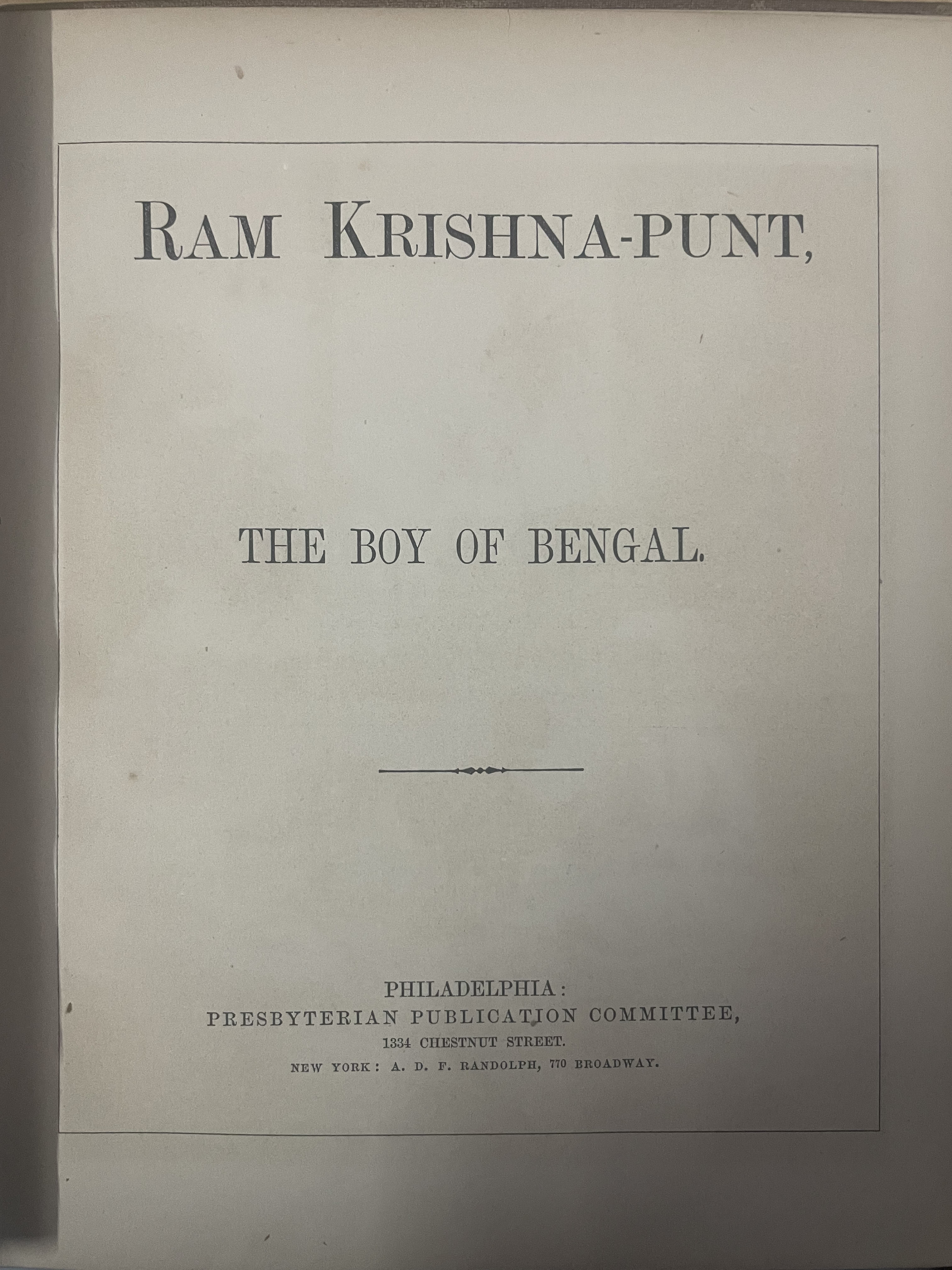Ram Krishna Punt The Boy of Bengal

About
Summary
Exquisite
TOC
Details
Related
URL
Images
Overview
Ram Krishna Punt: The Boy of Bengal, written by W. M. Hildeburn and published in 1866 by the Presbyterian Publication Committee in Philadelphia, tells the story of a young Bengali boy named Ram Krishna Punt and provides insights into 19th-century Bengali culture and society. The book explores themes of personal growth, cultural traditions, and the impact of societal changes on individual lives.The book is a historical novel that depicts the life and experiences of Ram Krishna Punt, a boy growing up in 19th-century Bengal. Through Ram Krishna’s experiences, the novel provides readers with a detailed portrayal of Bengali society, customs, and traditions during this period. The book follows Ram Krishna’s daily life, education, and personal growth, highlighting his challenges, learning experiences, and personal development.
The book likely begins with Ram Krishna’s birth and early life, introducing his family and his early environment. It explores his childhood adventures and experiences in his village. The narrative probably describes Ram Krishna's education and school experiences, highlighting his intellectual and personal growth.
The book delves into the daily life in Bengal, describing cultural traditions and community interactions. It likely presents accounts of major festivals and events that impact Ram Krishna and his community. The story probably shows the protagonist facing and overcoming various personal and social challenges. It also features Ram Krishna’s reflections on his life as he matures, including his changing perspectives and insights. The book likely concludes with a summary of Ram Krishna’s journey and reflections on his experiences.
Importance of Book
Ram Krishna Punt: The Boy of Bengal is a valued historical document that provides readers with an understanding of the culture and social structure of Bengal during the 19th century. It offers a portrayal of the education system and childhood experiences in a historical context, enriching readers' knowledge of this period. The novel serves as a historical document that provides readers with an understanding of the culture and social structure of Bengal during the 19th century.
Historical and Cultural Context: The novel serves as a historical document that provides readers with an understanding of the culture and social structure of Bengal during the 19th century.
Educational Value: It offers a portrayal of the education system and childhood experiences in a historical context, enriching readers' knowledge of this period.
Key Themes
Personal Growth: The novel explores Ram Krishna’s journey from childhood to adolescence, highlighting his challenges, learning experiences, and personal development.
Cultural Depiction: The book provides insights into the social customs, traditions, and daily life in Bengal during the 19th century.
Social Commentary: The novel reflects on the societal norms and expectations of the time, providing commentary on the changes and continuity within Bengali society.
Cultural traditions: The book explores the cultural traditions of 19th century Bengal and their impact on the life of the protagonist.
Impact of societal change: The novel explores the impact of societal changes on the lives of individuals in 19th century Bengal.
Cultural Significance
Ram Krishna Punt: The Boy of Bengal is significant for its portrayal of Bengali life and culture through the perspective of a young boy, providing both historical and social insights into 19th-century Bengal. The book offers insights into the social customs, traditions, and daily life in Bengal during the 19th century. The novel serves as a historical document that provides readers with an understanding of the culture and social structure of Bengal during the 19th century.
Effects on Society
Ram Krishna Punt: The Boy of Bengal likely had a limited direct impact on Indian society at the time of its publication, as its primary audience was likely Western readers interested in learning about life in Bengal. However, the book's portrayal of Bengali culture and society may have influenced Western perceptions of India and its people.
Here are potential effects:
Shaping Western Perceptions: The book may have contributed to shaping Western perceptions of India and its culture, particularly among readers interested in missionary work or colonial administration.
Promoting Cross-Cultural Understanding: The book could have fostered greater cross-cultural understanding by providing Western readers with insights into the daily life, customs, and values of Bengali society.
Reinforcing Stereotypes: Depending on the author's perspective and biases, the book may have inadvertently reinforced existing stereotypes about India and its people.
Inspiring Missionary Interest: The book's portrayal of life in Bengal may have inspired some readers to become involved in missionary work in India, seeking to bring Christianity and Western values to the region.
Conclusion
Ram Krishna Punt: The Boy of Bengal by W. M. Hildeburn, published in 1866, is a historical novel that provides insights into 19th-century Bengali culture and society through the life and experiences of a young boy named Ram Krishna Punt. The book explores themes of personal growth, cultural traditions, and the impact of societal changes on individual lives. It is valued for its portrayal of Bengali life and culture through the perspective of a young boy, providing both historical and social insights into 19th-century Bengal. The book may have influenced Western perceptions of India and its people, promoted cross-cultural understanding, or inadvertently reinforced existing stereotypes.
Title
Ram Krishna Punt The Boy of Bengal
Author
W M Hildeburn
Name of Publisher
Pressbyterian publications committee Philadelphia
Publish Date
1866
Subject
The book explores themes of personal growth, cultural traditions, and the impact of societal changes on individual lives
Vintage
1801-1900
Number of Pages
40
Category
Literary
Sub Category
India
Rarity
RARE
